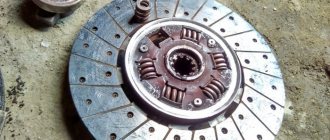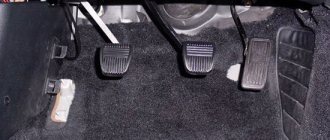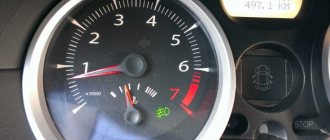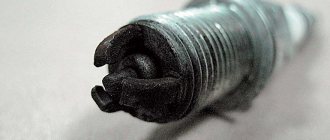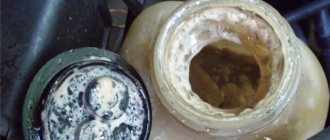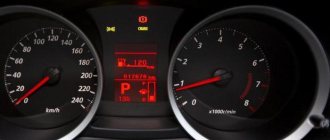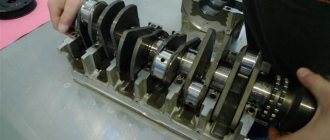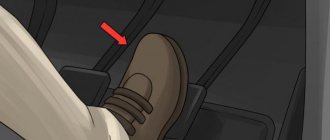The problem with clutch slipping on cars that are usually classified as domestic classics is quite well known. This defect not only causes serious inconvenience in driving, but also entails unplanned financial losses. Clutch slipping leads to fairly rapid failure of the release bearings, wear of the discs and combustion of the entire basket as a whole. This article is intended to answer the questions: why does the clutch slip and what needs to be done in a particular case?
How to determine this defect?
Clutch slipping can be easily detected independently, without the use of special equipment.
To do this, you need to perform the following series of simple steps:
- start the engine;
- engage neutral gear;
- apply the handbrake;
- press the gas pedal;
- depress the clutch;
- go to first speed;
- release the clutch pedal.
By all rights, as a result of these manipulations, the engine should eventually stall. If this does not happen, the engine continues to work, and even extraneous sounds or a burning smell appear, this means that the clutch is slipping and measures to repair it should be taken immediately. This is caused not only by financial reasons, but also by reasons of personal safety.
Leveling up
To bleed, you will need brake fluid and a container for draining it, as well as a transparent hose with a diameter of 5mm. and an assistant who will have to press the clutch pedal until heaviness appears in it. After this, it must be clamped, and at this time a second person must unscrew the fitting and drain all the brake fluid. Air bubbles will be visible in the hose. The procedure should be repeated until these same bubbles disappear. Also, do not forget about the fluid level in the expansion tank.
Causes of clutch slipping
There may be several reasons causing this effect. As a rule, they arise due to a characteristic driving style, which is commonly called sporty. Sharp acceleration and braking, frequent gear changes significantly reduce the working life of the clutch, although AvtoVAZ defines it as 75-85 thousand kilometers. In addition, experts say that the performance of a car’s clutch can be significantly affected by the use of trailers. It is believed that they are capable of significantly shortening the life cycle of components and mechanisms of an automotive element. Let's look at the most common actual causes of clutch slipping.
Clutch adjustment VAZ 2107
Clutch adjustment is a mandatory step after troubleshooting or replacement.
When dismantling the gearbox, basket, or driven disk, the control rod is usually unscrewed, so after assembly, the adjustment must be done again. This is also necessary if during the operation of the car, for one reason or another, the clutch on/off mechanism is broken. It's quite easy to make the adjustment yourself. To do this, you will need an inspection hole, overpass or lift.
Tools and materials
- open-end wrenches for 8, 10, 13 and 17;
- measuring ruler or construction corner with divisions;
- pliers;
- Cobra pliers;
- water-repellent composition WD-40.
The clutch adjustment is carried out after bleeding the hydraulic drive.
Adjusting the pedal free play
The pedal free play should be from 0.5 to 2.0 mm. It is regulated from inside the car by changing the reach of the clutch pedal limiter.
The procedure for this is as follows
Adjusting the free play of the fork rod
The free play of the fork rod is the gap between the release bearing and the fifth diaphragm spring of the pressure plate. Its adjustment is carried out on the inspection pit or lift as follows.
Adjusting the fork rod
The threaded part of the rod is not protected from dirt and moisture, so the adjusting nut and locknut may not immediately unscrew. It is recommended that after cleaning the rod from dirt, apply WD-40 to the threaded part. You are then prompted to perform the following steps.
- Holding the adjusting nut with a 17 wrench, use a 13 wrench to loosen the lock nut by 2-3 turns.
- We lock the rod with Cobra pliers and, turning the adjusting nut with a 17mm wrench, set the free play of the rod within 4–5 mm.
- We tighten the locknut with a 13mm wrench, holding the rod from turning with Cobra pliers.
After adjustment, when tightening the locknut with a 13 wrench (c), the adjusting nut is held with a 17 wrench (b), and the flats of the rod are held with Cobra pliers (a)
- start and warm up the engine to operating temperature;
- Depress the clutch pedal and engage first gear;
- turn off first gear and engage reverse.
A properly adjusted clutch should press out easily, without jamming. Speeds switch on without difficulty or noise. When driving, there should be no slipping of the driven disk.
Oil ingress
Often, if the clutch slips, the reasons for this lie in oil or other technical fluid getting into the basket. Oil gets onto the surface of the release disc, flywheel or driven disc lining due to a leak in the rear crankshaft oil seal. Often the cause of a leak is an excessive oil level in the gearbox housing. In these cases, if the clutch slips, the VAZ-2107 can be repaired very simply. It will be enough to eliminate the cause of the leaks and clean those parts of the system that have received oil. This can be done using white spirit or gasoline. If liquid gets on the friction linings, they will also have to be cleaned with fine-caliber sandpaper.
Complete disassembly with gearbox removal
The work must be done on a lift or in a pit. First of all, remove the battery
We continue disassembly by removing the rod from the gear shift lever. Then you will have to use a screwdriver to unscrew the screws securing the cover that covers the hole in the car body. This completes the manipulations inside the car dealership. What needs to be done next:
- Remove the exhaust pipe (exhaust system) and resonators;
- Then remove the starter from the flywheel housing and move it to the side;
- Disconnect the cardan from the rear axle and gearbox.
To be able to remove the box, remove the cross member of the rear engine mount and the speedometer drive cable. You also need to disconnect the hydraulic drive cylinder from the gearbox and move it to the side.
Next, you will need to remove the bolts that hold the clutch housing cover in place (key 10) and proceed to dismantling the box, and since it weighs a lot, it is worth putting a good support under it.
Read, it may come in handy: Checking the functionality and replacing the vacuum booster
After this, use a socket wrench to unscrew the bolts from the flywheel housing. Now, in order to remove the box, you will have to carefully move it back, slowly removing the primary shaft from the hub of the clutch driven disc. This must be done carefully so as not to drop the box and injure yourself. That's it, the box is removed.
Video about disassembling the clutch using the example of a VAZ 2106, suitable for the “Seven”, a small difference only in the interior
Disc lining wear
Friction linings on discs tend to wear out over time.
As a rule, this not only causes the clutch to slip, but also significantly reduces the free play of the pedal. In this case, there can be only one way out of this situation - replacing the entire clutch linings or discs. It must be remembered that if only the linings are replaced, then you need to pay careful attention to the condition of the gaskets. If they have damage or burnt areas, they also need to be replaced.
Causes of wear of the clutch mechanism
As car manufacturers assure, the average service life of clutch discs ranges from 75 to 80 thousand kilometers. A quiet driving mode and infrequent gearbox shifting help to extend the service life of the analyzed elements. Unfortunately, not all car owners adhere to such recommendations, and this, in turn, leads to rapid wear of the clutch mechanism. As a result, the worn mechanism slips while moving and at speed.
A clutch disc malfunction is manifested by incomplete engagement or periodic slipping.
In the first case, the pedal travel is too large. That is, if the pedal fails when the gearbox is turned on, and at the moment of shifting there is a kind of crunching sound, these are clear signs that the clutch discs are not fully engaged.
When slipping occurs, on the contrary, there is insufficient pedal travel, which can be completely released and free.
In any case, the operation of the clutch disc system should be adjusted as quickly as possible.
Insufficient pedal free play
The clutch often slips (the VAZ-2107 often suffers from this) also because the pedal has too little free play.
The manufacturer has established a value range of 25… 35 mm. This indicator can be easily measured with a simple ruler and adjusted if necessary.
There are other reasons why the clutch of VAZs of any model, and the “Seven” in particular, slips.
They are not as common as those listed above. But you still need to know about them. In particular, the following malfunctions can be mentioned:
- Detachment of the friction lining. The lining itself may not have visible damage or burnt areas. But as a result of delamination, it ceases to take the load over its entire surface, which leads to slipping.
- Overheating of the release disc. As a result of the temperature exceeding the maximum possible heat-absorbing characteristics of the clutch disc, it permanently expands, which causes a slipping effect. Of course, this defect cannot be determined on the fly. But it can be determined quite easily by the characteristic residue of burning and scale on the disk itself.
This article lists the main reasons why the clutch slips on domestic classics and on many other models of cars and trucks. It is important to remember that, whatever the cause of clutch slipping, it must be eliminated at the first appearance of symptoms of the defect. It is best to entrust such work to highly qualified specialists.
Disassembling, repairing and replacing clutch parts is quite labor-intensive work and requires fairly deep knowledge, extensive experience, as well as the availability of special tools and equipment.
In addition, when doing repair work yourself, there is a fairly high risk of violating the correct settings and adjustments, which will turn replacing parts into a Sisyphean task. Very soon the clutch will again begin to slip, make grinding and crackling noises, and the smell of overheated discs and linings will be clearly felt in the car's interior.
Replacing the clutch yourself
When replacing the clutch, you should carefully inspect all the parts being removed; it is quite possible that you will not need to replace the entire assembly; it will be enough to change only some parts.
The clutch is replaced in the following sequence:
- The battery terminals are disconnected.
- The gear shift lever is disconnected from the transmission.
- The exhaust pipe is disconnected from the resonator, then the working cylinder is disconnected from the gearbox housing. The cardan is disconnected from the gearbox itself.
- The bolts securing the starter to the transmission housing are unscrewed, but before doing this, the two lower nuts that secure the transmission to the engine block must be loosened.
- The gearbox is removed, then the clutch basket is dismantled. After removing the basket, the clutch disc is released
- At this stage, if necessary, the master cylinder and other components are replaced, for example, the clutch fork or antennae on the basket are changed.
- Assembly and installation of the unit is carried out in the reverse order.
When assembling, all parts must be thoroughly washed, but under no circumstances should this be done in gasoline or oil. Lubrication is carried out only with brake fluid.
The clutch is one of the most important components in a car, without which it simply will not move. Therefore, this complex system requires proper attention and care. Malfunctions in the clutch operation can lead to spontaneous movement of the car, and this is a direct threat to the lives of others.
Not really
A few words about the principle of operation of the clutch. The operation of any engine in a car ends with the rotational movement of a heavy flywheel. By controlling the accelerator, you can only increase or decrease the speed of rotation of the flywheel. In order for the car to move, it is necessary to transfer this movement to a mechanical gearbox - a gearbox. It is very necessary to transmit this rotational movement, otherwise the engine will simply stall. The same operation - smooth disengagement of the transmission - is also necessary when stopping the car. The clutch is such a “soft” switch.
The operating principle of this device is easy to understand. Imagine two rotating discs the size of a small steering wheel. One of them is the engine flywheel, and the second is the clutch disc. If, while the flywheel is rotating, the disk from the gearbox is pressed tightly against it, the rotational motion will be transmitted and the car will begin to move. It seems very simple. Everything works like this, only the discs are compressed using special mechanisms, and special gaskets are installed between them.
The main faults may be poor disk compression or untimely partitioning. The clutch is said to be "driving" or "slipping."
Signs of a Worn Clutch
- Getting started in a car has become quite difficult. To be precise, the pedal must be moved as far as possible and only then the car starts moving. Another variant of this problem could be that the gears are too difficult to engage or even squeal.
- Noticeable loss in power. It is expressed in the fact that when driving fast, especially in lower gears, dips appear: the car jerks and this effect intensifies each time. The expression “clutch slips” refers to this malfunction. The disc does not press tightly and slips from time to time, creating discomfort when moving. The car is clearly going quite poorly going uphill.
We fix problems
The following factors indicate that the VAZ 2107 clutch is starting to slip:
- unpleasant odor;
- the car accelerates hard;
- When climbing a mountain the engine lacks power.
In order to understand whether the VAZ 2107 clutch is slipping or not, you need to:
- tighten the handbrake;
- turn on the speed and begin to gently squeeze the gas, while at the same time releasing the clutch pedal;
- if the engine stalls, you can be sure that the clutch system is working properly;
- If the engine stalls and the car is moving, then we can say with confidence that the clutch of your car is slipping.
What to do in such a case? First you need to check the VAZ 2107 clutches for ease of movement. Having identified problems, try to correct them by adjusting them. It is likely that the system is slipping due to worn-out clutches. In this case, you need to find out the degree of wear. If the wear is insignificant, then in order to eliminate slipping, it is enough. If the wear is significant, then it is necessary to replace the driven disk and linings. This is necessary if the distance between the working parts and the rivets is more than 0.2 millimeters.
Often, for various reasons, the linings become oily, mainly due to an increased level of lubricant in the gearbox or due to the fact that the flywheel drain holes are clogged. The way out of this situation is very simple: just wash the pads with a liquid like kerosene. Then all surfaces must be wiped and cleaned with sandpaper.
Clutch slipping can be caused by swollen rubber parts of the hydraulic drive. In order to prove or disprove this, you need to take the following steps:
- remove the cylinders, including the main one;
- clean the system with alcohol;
- replace swollen parts with new ones;
- thoroughly clean the expansion holes;
- add brake fluid;
- bleed the brakes.
In cars older than ten years, slipping often occurs due to hardening of the pressure springs, which ultimately weakens the pressure on the driven disk, which leads to difficulties with slipping. In order to determine the condition of the springs, you need to completely remove the clutch disc. If necessary, replace the springs or even the entire clutch.
Welcome!
Clutch adjustment - thanks to this small procedure you can reduce the risk of wear on clutch parts such as the release plate, but only if the clutch is not adjusted, if it is adjusted, then if it works correctly, the risk of wear on clutch parts will be minimal during moderate driving. Therefore, if your clutch is not adjusted, we recommend that you read this manual so that you can adjust it in the future.
Note!
To make adjustments, you will need to stock up on: A basic set of wrenches, and for more correct adjustments, it is recommended to take a ruler or square with you. You will also need to use: Cobra-type pliers and pliers!
Summary:
Where are the clutch slave and master cylinders, which are used to adjust the clutch?
The slave cylinder can be easily seen by looking under the bottom of the car; it is located at one end on the gearbox itself and the other end is inserted into the clutch fork; for more details on the location of the slave cylinder, see the photo below:
The master cylinder is located in the engine compartment of the car; in order to see it, there is no point in climbing under the bottom of the car, because after opening the hood it can be easily seen.
When should you adjust your clutch?
The clutch is adjusted when very significant play appears when the clutch pedal is pressed, or when there is no play at all, just for the record! The initial free play of the pedal should be “0.4 – 2.0 mm”; if it is more or less, then adjust the system.
Note!
And also, just in case, measure the free travel of the clutch pedal before it is turned off, which should be within the norm - “25 - 35 mm”!
The system also needs to be adjusted, if between the pusher, which is indicated by the red arrow, and the clutch fork, which is indicated by the blue arrow, the free play is completely gone or it exceeds “4-5 mm”, it is very easy to check this movement; for this, grab the clutch fork with your hand as shown in the figure, and then rock the fork from side to side.
Note!
In fact, this operation does not need to be carried out, but it is best to focus all your attention on checking the free play of the clutch pedal, because as a rule, if it is normal, then the free play of the pusher and clutch fork will also most likely be normal. But still, if you want to check the fork, then check it, otherwise, due to the large free play in the forks, the release bearing will be subject to constant load, which is why in the near future it may become unusable, and therefore it will have to be replaced!
How does the clutch slip?
If, when the car is moving, there is a burning smell, the acceleration of the car has become worse, and there is a noticeable decrease in speed when overcoming an incline, then this is a clear symptom of a malfunction - slipping. To clarify this diagnosis, you can engage the gear with the engine running and the handbrake applied. Then, smoothly pressing the control pedal, smoothly release the clutch pedal. If the engine stops, there is no slipping, but if it continues to work, the clutch slips.
The reasons for this unpleasant phenomenon may be: violation of the free play of the pedal, wear or oiling of the friction linings, wear of the pressure springs, or a malfunction of the clutch release hydraulic drive.
Replacing the master and slave cylinders
The master cylinder is replaced in the following sequence:
- Liquid is drained from the reservoir. This can be done using an ordinary syringe, or by removing the hose from the master cylinder fitting.
- The pipe fitting leading to the clutch slave cylinder is unscrewed.
- Using a 13mm wrench, unscrew the two nuts on which the main cylinder is attached.
Replacing the working cylinder:
- The spring is removed from the working cylinder.
- Using a 10mm wrench, unscrew the tube connecting the master and slave cylinders.
- Using a 13mm wrench, unscrew the two bolts of the working cylinder and remove them together with the plate.
After replacement, the working cylinder must be bled.
What actions should be taken if the clutch slips?
First, let's try to extend the life of the disk. To do this, you can change the position of the disk relative to the flywheel accordingly. For this purpose, a special adjustment device is provided in the car interior or under the hood. By tightening the corresponding nuts, we can raise the pedal, thereby pressing the clutch disc harder against the flywheel. This method is recommended only for those who have not yet worn out the friction linings on the working part of the part. Therefore, it is not recommended to use it in all cases.
The most rational and correct solution is to replace the clutch, but before that, you need to get to the garage. This must be done with extreme caution. To avoid problems, you need to drive with the lowest number of revolutions. It is necessary to start moving “under load”. This means that the clutch needs to be released as smoothly as possible, but at the same time add a minimum of gas, or even not at all. Gear shifting should be performed according to the number of revolutions prescribed by the manufacturer.
Why does the clutch fail?
The clutch disc is a consumable item and sooner or later still needs to be replaced. It is impossible to repair a worn disk. The fact is that when it comes into contact with the flywheel, it begins to grind down for a while and only then the parts interlock with each other. Thus, the thickness of the clutch decreases and eventually the disc loses its function.
You can also “grind off” the clutch in a quick way. Many drivers, when starting to move, press the gas too hard and at the same moment quickly release the clutch pedal. At these moments, clutch wear increases significantly and then it will need to be replaced quite soon. Rapid disc wear is also achieved by driving quickly in low gears. At that moment, when the speed is high and the gear is selected too low, the clutch does not have time to transmit the required torque to the intermediate shaft and begins to slip. Thus, it receives additional “unnecessary” friction and wears out quickly.
Another reason is that engine oil gets on the working part of the disk. The problem is quite rare, but it also occurs. The fact is that when the rear crankshaft oil seal wears out, oil leaks to the engine flywheel. The oil remains on the clutch surface and friction is reduced, thus causing the disc to “slip.”
